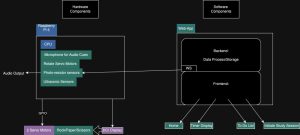After finishing the final presentation slides earlier this week, the team got together to plan a final week schedule. In here, we broke down some of the remaining tasks we had to complete. For me, I was prioritizing finishing the Study Session feature with Shannon, as well as the RPS.
While the study session took longer than anticipated, we were able to make it such that the study session (in DSIdisplay.py, and studysession_start.html, studysession_inprog.html, and studysession_end.html contained all the necessary code for expected behavior. We were able to abide by the choices in our design report and ensure that all features were implemented. Now all that is left is verify the study session integration with other features, as well as pushing our Web App to AWS servers. For validation and testing, we worked on verify individual components, such as duration being sent to the RPi, or actions such as pause/resume will trigger the appropriate HTML redirection. For instance, we see “study session in progress” on the Web App, and when we press pause on the DSI display via touchscreen, we see the Web App instantly change to “study session on break”. This kind of low latency behavior is exactly what we expected. Similarly, with studysession end, we address the multiple cases, where we either end a session early (from the Web App), in which case we need to handle the timer stopping completely, or a study session ending upon reaching the desired goal duration. In the latter case, we had to handle two additional cases: 1) Student user chooses to stop studying, and we go back to the default home screen, or 2) Student continues studying, in which case there is no longer a target goal duration, the student can study as they please, but keep the timer running (from where they left off) so they can track their total study time while retaining pause + resume functionalities.
Furthermore, on Thursday and Friday, I worked on the RPS display, and am able to finish our contingency plan, where the user can take a break and play multiple rounds of RPS by sending a number of rounds to play (from Web App). We are able to play X # of rounds, and after the final round, the DSI display screen will redirect back to home. I handle cases such as when no inputs are pressed. All code written is linked in the first 15 pages of the google doc: https://docs.google.com/document/d/17t1l_ZAiQ-rBkdr-X1iHHmmFroEZomcFpkQHONkKzW4/edit?tab=t.0
In the next upcoming week, I will keep working on keypad button integration, as we try to refactor our code from software/touchscreen, to just relying on the hardware components. I plan to do this with evdev and the USB-C keypad we have purchased (listed in our BOM). I also have broken down our frame states, and with Shannon, we drew out the expected behavior of our screen for the RPS feature. We plan to use both keypads for RPS, and pause/resume study session
I have also done a lot of system testing, both individual, and for integration. Overall, the testing helped me uncover a lot of issues to debug on the software side. In terms of design changes, there aren’t any drastic changes from what we had written up in the design report, and in fact, I believe we have been able to make improvements to the UI logic and handling various inputs. For the websocket validation and hardware abstraction, we are still working on integrating those final aspects but with thorough unit testing, we should be able to combine these aspects without running into major issues.

